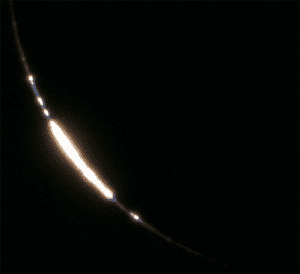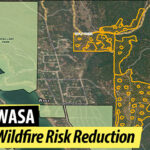Home »

Partial solar eclipse occurring Saturday morning
By Rick Nowell
There is a partial solar eclipse predicted in Cranbrook on Saturday Oct 14, 2023 starting at 9:11 a.m. for 2.5 hours.
At peak, the Moon will cover 67% of the Sun at 10:25 a.m.
The Moon will start to pass between us and the Sun at Oct 14 at 9:11 am. The Maximum coverage is at 10:25 am, and it will end at 11:44 am, local time MDT. Duration should be 2h, 32m.
Source: Xavier M. Jubier from his interactive map. Just click on his Google map at whatever city you like to get viewing times in UTC. Kimberley is almost identical.
 Above and right are photos I took of the previous Cranbrook eclipse of Aug. 21, 2017: This photo is an animated GIF, EclipseCE.gif, a slideshow showing five photos, taken every 15 minutes. Those spots at centre at sunspots. The true colour of the Sun is yellow, the reddish colour is an effect of the Thousand Oaks light filter attached to our Celestron 11” telescope. It reduces light by 100,000, and blocks all blue light.
Above and right are photos I took of the previous Cranbrook eclipse of Aug. 21, 2017: This photo is an animated GIF, EclipseCE.gif, a slideshow showing five photos, taken every 15 minutes. Those spots at centre at sunspots. The true colour of the Sun is yellow, the reddish colour is an effect of the Thousand Oaks light filter attached to our Celestron 11” telescope. It reduces light by 100,000, and blocks all blue light.
Ring of Fire/ Diamond Ring (pictured below right) is not visible here. Cranbrook is north of the path to see the Ring of Fire, but the Moon will still block a big two-thirds chunk of the Sun from the edge. But it won’t be centred.
For the best view of this “ring” eclipse with the Moon going through the centre of the Sun, with 89% of the Sun blocked, it may be worth travelling to southeast Oregon, just south of Eugene and north of Medford. To Crater Lake National Park in Oregon. Or to northern Nevada. See the path on the map given by the link.
Along the centre of the path, you will see a perfect Ring of Fire for a longer time.

If you are slightly North or South of the path, The Moon will be off-centre to the Sun, and you will see a very thin ring of fire on one side—which will form Baily’s beads due to the jagged mountains and craters along the edge of the Moon. Below is a photo from Wikipedia by Tom Ruen, of Baily’s Beads, four seconds before totality, Aug. 21, 2017.
Predictions by Fred Espenak and Computations by Xavier Jubier.
If you’re up Mt Baker, I wonder if you could see the shadow of the Moon sweeping in from the west over Cranbrook? It’s approaching at around 3,600 km/h; or 60km per minute; or 1.0 km/s. That’s 3.2x the speed of sound, so a military jet could keep up with it, but a car can’t.
The last Partial Solar Eclipse in Cranbrook was Monday morning Aug. 21, 2017, at 11:30 a.m. The Moon covered 85% of the Sun that time.
There was a mini-viewing party outside by the College of the Rockies gym that Monday morning, looking at the partial solar-eclipse. Adults and kids were looking through the eyepiece of the college’s Celestron 11-inch Schmidt-Cassegrain telescope.
People were lined up to sit in the chair and peer through the eyepiece as the Moon moved across the face of the Sun. Some people in the line-up were having success taking photos through their smart phones by holding it up to the eyepiece. The telescope motors tracked the rising Sun by raising its barrel up quite a bit over the couple of hours and made us constantly adjust our chair height down to follow it. The telescope was set for a 44-power magnification.
 Viewers: The welding department provided welding shields we could look through. Some kids had made little pinhole solar viewers: cardboard shoe boxes with aluminium foil on one end punched with a pinhole, and the sun was projected onto the far shadowed end. Some had real eclipse glasses.
Viewers: The welding department provided welding shields we could look through. Some kids had made little pinhole solar viewers: cardboard shoe boxes with aluminium foil on one end punched with a pinhole, and the sun was projected onto the far shadowed end. Some had real eclipse glasses.
David Shortridge had a welding glass plate (4”x5” shade 10) viewer and eclipse glasses he shared. It was odd to look directly at the Sun and see it the same size as a full Moon, except with a black crescent shape!
I recall previous partial eclipses in Cranbrook on March 7, 1989, and back in Feb. 1979 (I went to Montana to see that one in totality, wow!). Other times were cloudy.
The Saturday morning weather forecast is mostly cloudy. Let’s hope for clear gaps in the eastern sky.
Eye Hazard Warning: as most of you already know, view the eclipse with dark welding glasses or proper solar eclipse viewers. Do not observe with naked eye. Never use binoculars. The Sun can burn your retinas and cause blindness. Telescopes must have proper solar filters on the objective lenses and caps on the finderscope lenses at all times. Watch your kids observe these precautions.
Photos submitted
– Rick Nowell is Astronomy Lab Tech at College of the Rockies







